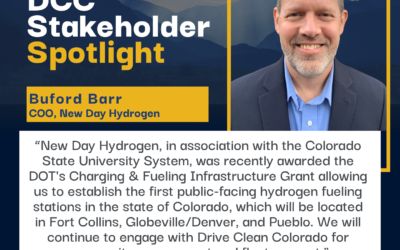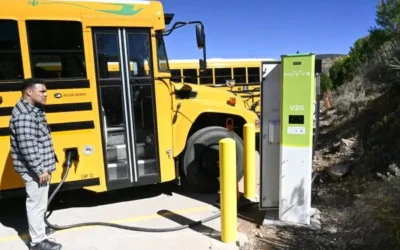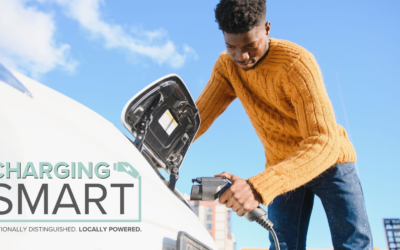We are very fortunate to have the Boulder Valley School District (BVSD) as one of our members at Denver Metro Clean Cities. BVSD is located in the foothills of the Rocky Mountains and has 56 different schools located in 11 different communities stretching from the Continental Divide to the suburbs of Denver. Landon Hilliard, Safe Routes to School Coordinator for the Transportation Department of BVSD, spoke with us about his role in BVSD and what the district’s sustainability goals look like. Keep reading to hear all about BVSD’s brand-new all-electric school bus!
Organization: Boulder Valley School District 
Location: Boulder, CO
*Note: These answers are summarized from an interview with Landon Hilliard from BVSD
Can you tell me a little bit about yourself and your role at the Boulder Valley School District?
I am the coordinator of the Safe Routes to School Program for the Boulder Valley School District (BVSD). I’m part of a unit within the Transportation Department that looks at alternative transportation – the gist behind our effort is just to reduce car trips and replace them with walking and biking. The work we do has a public health, social health and, of course, environmental health element and is all done through the Safe Routes to School brand. The goal is to reduce car trips by offering other transportation options and I’ve been assigned related projects around the electric school bus (ESB) and cleaning up our fleet.
How long has that program been running? Have you seen any big reductions in car trips since it started?
That’s a good question – anecdotally, yes. We have a bicycle education program that teaches students in fourth through seventh grade skills and knowledge of bike riding – we even bring bikes to PE classes with trained instructors. This is just one example of our efforts to educate and encourage walking and biking, and what we’ve seen over the years is an upsurge in the high school level of bicycling. When I started many years ago, it was still somewhat uncommon to ride a bike to school in Boulder. Over time, the culture has shifted, and not just in the BVSD. Transitioning toward using bikes more often and understanding that there are environmental benefits in doing so has shifted the perspective, and we now have high schools with bicycle racks that are packed, where 10 years ago we didn’t. One of the weaknesses of our program is evaluation – do we really know if there’s been a mode shift from single-occupancy vehicles to walking, biking and transit? We think so, and in some cases, we can prove it, but what we’re working on now is a comprehensive package of mode-share assessment across the district. We have 56 schools, 30,000 students and the BVSD covers 500,000 square miles – this is a big audience. Add staff of about 3,000 and parents of about 50,000, we’re talking about a 75,000 person audience for Safe Routes to School and this transportation demand management effort. It’s a fantastic audience to reach and we think we’re making progress internally, especially with the culture around walking and biking shifting. We’re still an auto-centric society, even in “gold plated” Boulder, and we still have a ways to go, but there is progress being made and we are hopeful for the future.

BVSD recently added an ell-electric Bluebird school bus to their fleet, what has that been like so far? What are the reactions from the drivers and the kids? Are there any plans to add more ESBs?
It’s been so encouraging. We waited 30 months from the time we were awarded funds through RAQC and the Alt Fuels Colorado Grant to the time of delivery, which was just last month in March. The delay had nothing to do with the granting agency, it had to do with the technology of electric buses. When the original bus we ordered was scheduled to be delivered, we learned it had some deficiencies. One of them, a prime one, was that the battery packs were not insulated in a way that would cushion them from temperature extremes. What this meant is during the cold weather months, which for us is half the school year, we’d have to keep the thing indoors to maintain a stable environment. This meant that we would not only have to give up an entire indoor garage bay to house this bus, but we would also have to wire it and set up the infrastructure. Among other limitations, this didn’t sit right with us, so we held out, had a nice conversation with the manufacturer, with our vendor, Colorado West, and waited for the next generation Bluebird Vision Electric. The new Bluebird arrived in March 2021 and it’s a beautiful, gleaming, clean, quiet, highly efficient machine, just as we hoped. It’s currently on regular runs on flat land routes, so we’re essentially putting it through its pace, poking and prodding. Through the DMCC Coalition, we’re working with a couple of consultants, EV WATTS and CALSTART, for telematics so we can track every little detail of how the bus operates.
Our fleet manager, Kevin Cole, is giving drivers the opportunity to test the Bluebird, so we’ve had half a dozen or so drivers behind the wheel. Everybody loves it. The one comment we’ve gotten is that the bus is so quiet, the drivers can hear student conversations in the back seat, something that never came up with traditional gas and diesel buses. Besides that there have been not been any complaints about the bus, it really is a clean, quiet interior experience and everyone loves it so far.
For all ostensible purposes, it’s a regular school bus, it just happens to be powered by electricity – no one knows from a quick glance that it’s anything different. To that point, we’re hiring a branding agency to partially wrap the bus with messages like “100% electric” and “Where’s the tailpipe?” to draw attention and awareness. We also plan to have a focus group session with high school students across the district involved with ecology clubs to bring up the youth voice for electrification. We are looking to have a real debut for the bus in the fall.
If you ask me, there is a sort of grand vision for adding more electric school buses. If you ask someone else who is more grounded in physical and operational constraints, then you might hear a different answer. The director of transportation, Tony Skala, and our fleet manager, Kevin Cole, agree on what might be a fleet composition in the future. There’s no date attached to it, but what they’ve talked about is making 50 percent of the fleet electric, 25 percent propane and the remaining 25 percent gas and diesel. Right now, the school district is thinking about a fleet management bus replacement cycle that makes sense and that we can afford, which, if I have my druthers in the conversation, will include adding an electric bus every round, every year. I wear my enthusiasm for electrification on my sleeve, and while people agree with the vision, they don’t always agree or understand how we might get there. With the Alt Fuels Colorado Grant and support from RAQC and DMCC, I think we have the political will and financial support to do it.

What advice would you give other school districts interested in adding EVs to their fleet?
First, I would council patience. Since we are a rather conservative industry, it may take some persuasive effort to make the case for electric school buses. If you have the patience to wait, the case for ESBs will be made, simply because the ramp-up to electrification is happening so rapidly – we can use California as an example. Decision makers, procurement specialists and so forth will see the writing on the wall, so to speak, and be more inclined to get into the up and coming technology. The other advice I have is to be hopeful and understand that there’s loads of technical support and financial assistance in Colorado for electrification. BVSD’s tactic of acquiring one ESB and seeing how it runs is proof of concept that most school districts might be able to swallow. There’s a great premium right now for an ESB, so while the convincing on the financial end has to be strong, I believe that once the bus is operating and the numbers come back for the reduced operating costs and lower maintenance, there will be threads of the argument that come together to make a strong case for future purchases. We must keep in mind that we’re still at the beginning of this journey and not everyone appreciates the value of electrification. It’s not necessarily just an environmental push, it’s the economic case as well, and that’s what everyone would recognize if we gave it a little more time.
What are BVSD’s sustainability goals? How can DMCC help support those?
Coincidently, we are in the process of updating our sustainability energy management system, which is basically our blueprint for sustainability for the next 5 years. Transportation is a key element in our sustainability energy management system, and we are being somewhat aggressive in our goals to reduce fleet carbon emissions and miles traveled. We are having discussions about setting attainable sustainability goals and we’re using the SMART metric to make sure they are specific and measurable. There is some back and forth because on one hand, the heart is saying “let’s go all-in with this” and the more rational head is saying “Can we afford this? Will these buses be viable in our fleet?” – this goes back to the continuum of those who are greatly enthusiastic to those who need to be persuaded. BVSD has a strong environmental ethic, and we understand the urgency of what’s happening in our climate as well as the responsibility our district has to do our part for cleaner air. It’s encouraging to know that there’s policy support from the board of education and I am hopeful that we will have a strong, attainable goal so people will understand that electrification is a realistic effort.
Your organization has done so much already to bring together stakeholders, educate the public, and present new and compelling ideas for decision makers to consider. It’s clear that DMCC staff are passionate about what they do. You have a mission, and it you’re following through with functional and practical strategies to support it. I would say keep on keeping on! All the things that you are doing to bring people together around this subject to see where the questions and barriers are and how to work through them is a significant advantage for our area.
What do you hope to work with DMCC on in the future?
I would like to build on the ESB Working group, spread the word and generate enthusiasm and understanding for school bus electrification. We’ve got to keep the loudspeaker on to bring more people into this group and build momentum – there is a mutually supportive effect that way. When I can speak to my decision makers about the fact that the Denver Public Schools is acquiring a dozen buses, or our next-door neighbor, St. Vrain Valley School District, is looking into it, then there’s a little bit of peer pressure, but mostly just comfort that we’re not so far out front that we could be making a mistake with this technology. Building this coalition, which is what you all are doing, is just the right thing to continue in the school bus sector.

See more DMCC Member Spotlights or learn more about joining DMCC today!






